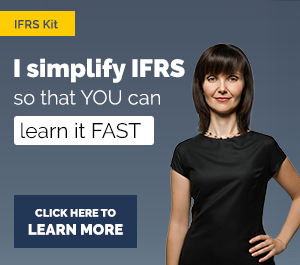IFRS 17 Example: Initial Measurement of Insurance Contracts
Trying to make IFRS 17 complexity a bit easier, here’s the practical numerical solved example of initial measurement of insurance contracts, using the general model under IFRS 17 Insurance Contracts.
Please see the following topics:
- The main principles of initial measurement under IFRS 17;
- Example #1: Insurance contracts other than onerous;
- Example #2: Onerous insurance contracts;;
- ***Free video lecture with examples***
Principles: How to measure insurance contracts initially
The main principle of the general model for measurement of insurance contracts under IFRS 17 is to
- Recognize the loss on onerous contracts immediately in profit or loss; and
- Recognize the profit on other contracts over the coverage period, not immediately at initial recognition.
As a result, at initial recognition, the insurance contracts are measured at:
- Zero, if the contracts are NOT onerous;
- Insurance contracts liability equal to the net cash outflows, if the contracts are onerous.
Example #1: Insurance contracts that are NOT onerous
Question #1
ABInsura, the insurance company, issues 200 insurance contracts with a coverage period of 4 years, starting at the issuance date.
The following information is available:
- The insurance premium is 15 CU per contract for the whole coverage period, payable within one month after its issuance;
- The annual future cash outflows are estimated at 3 CU per contract;
- The discount rate is 5%;
- Estimated risk adjustment for non-financial risk upon initial recognition is 200 CU.
How to measure the group of insurance contracts initially in line with IFRS 17?
Assume that no contracts will lapse within the coverage period (i.e. all of them will be completed).
Solution #1
According to IFRS 17, the insurance contracts are initially measured at the sum of:
- Fulfilment cash flows; in this example, we have:
- Estimates of future cash inflows, being premiums expected to receive from policyholders amounting to 15 CU per contract. That gives us 3 000 CU for the whole group of 200 contracts;
- Estimates of future cash outflows; being the insurance claims payments, servicing costs, etc. In this example, these amount to 3 CU per contract per year. That gives us 600 CU per year in the years 1 – 4.
- Discounting: It is necessary to bring these cash flows to the present value using the discount rate of 5% (given in question above);
- Risk adjustment for non-financial risks: 200 CU (given in question above);
- Contractual service margin: the negative value of the sum of all above items (fulfilment cash flows adjusted by discounting and risk adjustment) for non-onerous contracts.
The calculation is illustrated in the following table:
| Year | Cash in | Cash out | Net cash flow | Discount factor | PV of cash flows |
| 0 | 3 000 | 0 | 3 000 | 1.000 | 3 000 |
| 1 | 0 | -600 | -600 | 0.952 | -571 |
| 2 | 0 | -600 | -600 | 0.907 | -544 |
| 3 | 0 | -600 | -600 | 0.864 | -518 |
| 4 | 0 | -600 | -600 | 0.823 | -494 |
| Total | 3 000 | -2 400 | 600 | 872 | |
| Less risk adjustment | -200 | ||||
| The fulfilment cash flows | 672 | ||||
| Contractual service margin | -672 | ||||
| Initial measurement of group of insurance contracts: | 0 | ||||
Notes:
- The discount factor for the particular year is calculated using the formula 1/((1+5%)to the power of year) – please watch the video for illustration;
- PV (present value) of future cash flows is calculated as Net cash flow multiplied with the discount factor;
- Contractual service margin is calculated as the negative value of the fulfilment cash flows after risk adjustment.
As a result, initial measurement of insurance contracts other than onerous is zero and no journal entry is passed.
Then, when ABInsura collects the premiums from policyholders amounting to 3 000 CU, the following entry is passed:
- Debit Bank accounts: CU 3 000;
- Credit Insurance contracts liability: CU 3 000;
As a result, the measurement of the insurance contracts liability after initial recognition is a liability of 3 000 CU, which is shown in the following table:
| Year | Cash in | Cash out | Net cash flow | Discount factor | PV of cash flows |
| 0 | 0 | 0 | 0 | 1.000 | 0 |
| 1 | 0 | -600 | -600 | 0.952 | -571 |
| 2 | 0 | -600 | -600 | 0.907 | -544 |
| 3 | 0 | -600 | -600 | 0.864 | -518 |
| 4 | 0 | -600 | -600 | 0.823 | -494 |
| Total | 0 | -2 400 | -2 400 | -2 128 | |
| Less risk adjustment | -200 | ||||
| The fulfilment cash flows | -2 328 | ||||
| Contractual service margin | -672 | ||||
| Insurance contracts liability immediately after initial recognition: | -3 000 | ||||
Please note, that this table is identical as the above table, with one exception: the estimates of future cash inflows changed to zero, because no more premiums are expected to be received in the future.

Return to top
Example #2: Insurance contracts that are onerous
Question #2
The same question as in the example #1, just with one difference – the estimated future cash outflows changed from 3 CU to 5 CU.
To sum up all the information:
- 200 insurance contracts issued with the coverage period of 4 years;
- The insurance premium is 15 CU unit per contract for the whole coverage period, payable within one month after its issuance;
- The annual future cash outflows are estimated at 5 CU per contract;
- The discount rate is 5%;
- Estimated risk adjustment for non-financial risk upon initial recognition is 200 CU.
How to measure the group of insurance contracts initially in line with IFRS 17?
Assume that no contracts will lapse within the coverage period (i.e. all of them will be completed).
Solution #2
Similarly as in the example #1, according to IFRS 17, the insurance contracts are initially measured at the sum of:
- Fulfilment cash flows; in this example, we have:
- Estimates of future cash inflows, being premiums expected to receive from policyholders amounting to 15 CU per contract. That gives us 3 000 CU for the whole group of 200 contracts;
- Estimates of future cash outflows; being the insurance claims payments, servicing costs, etc. In this example, these amount to 5 CU per contract per year. That gives us 1 000 CU per year in the years 1 – 4.
- Discounting: It is necessary to bring these cash flows to the present value using the discount rate of 5% (given in question above);
- Risk adjustment for non-financial risks: 200 CU (given in question above);
- Contractual service margin: zero for onerous contracts.
The calculation is illustrated in the following table:
| Year | Cash in | Cash out | Net cash flow | Discount factor | PV of cash flows |
| 0 | 3 000 | 0 | 3 000 | 1.000 | 3 000 |
| 1 | 0 | -1 000 | -1 000 | 0.952 | -952 |
| 2 | 0 | -1 000 | -1 000 | 0.907 | -907 |
| 3 | 0 | -1 000 | -1 000 | 0.864 | -864 |
| 4 | 0 | -1 000 | -1 000 | 0.823 | -823 |
| Total | 3 000 | -4 000 | -1 000 | -546 | |
| Less risk adjustment | -200 | ||||
| The fulfilment cash flows | -746 | ||||
| Contractual service margin | 0 | ||||
| Initial measurement of group of insurance contracts: | -746 | ||||
As a result and in line with the main principle of IFRS 17, we need to recognize the loss on onerous contracts immediately.
Therefore, on initial recognition, the following journal entry is passed:
- Debit Profit or loss – Insurance service expenses: CU 746;
- Credit Insurance contracts liability: CU 746;
.
Then, when ABInsura collects the premiums from policyholders amounting to 3 000 CU, the following entry is passed (the same as in the Question #1):
- Debit Bank accounts: CU 3 000;
- Credit Insurance contracts liability: CU 3 000;
.
As a result, the measurement of the insurance contracts liability after initial recognition is a liability of 3 746 CU, which is shown in the following table:
| Year | Cash in | Cash out | Net cash flow | Discount factor | PV of cash flows |
| 0 | 0 | 0 | 0 | 1.000 | 0 |
| 1 | 0 | -1 000 | -1 000 | 0.952 | -952 |
| 2 | 0 | -1 000 | -1 000 | 0.907 | -907 |
| 3 | 0 | -1 000 | -1 000 | 0.864 | -864 |
| 4 | 0 | -1 000 | -1 000 | 0.823 | -823 |
| Total | 0 | -4 000 | -4 000 | -3 546 | |
| Less risk adjustment | -200 | ||||
| The fulfilment cash flows | -3 746 | ||||
| Contractual service margin | 0 | ||||
| Initial measurement of group of insurance contracts: | -3 746 | ||||
The free video lecture and the course on IFRS 17
You can watch the full lecture of initial measurement of insurance contracts under IFRS 17 here:
This is the full lecture from the IFRS Kit which now contains contains the full video lectures with many practical examples solved in Excel that will guide you, step by step, through the insurance contracts and their accounting.
Tags In
JOIN OUR FREE NEWSLETTER AND GET
report "Top 7 IFRS Mistakes" + free IFRS mini-course
Please check your inbox to confirm your subscription.
10 Comments
Leave a Reply Cancel reply
Recent Comments
Categories
- Accounting Policies and Estimates (14)
- Consolidation and Groups (25)
- Current Assets (21)
- Financial Instruments (56)
- Financial Statements (54)
- Foreign Currency (9)
- IFRS Videos (73)
- Insurance (3)
- Most popular (6)
- Non-current Assets (54)
- Other Topics (15)
- Provisions and Other Liabilities (45)
- Revenue Recognition (26)
- Uncategorized (1)




What happens when the premiums are received monthly, and not the day 1 3000 premium received. What do we debit as the cash is not received on day 1?
The explanation seems incomplete to me. How will the CSM later be released to P&L? How will be contract be subsequently measured after a cash outflow?
Hey Silvia, thanks for this wonderful presentation.
I want to know more about IFRS 17.. is there any special IFRS 17 kit available with you.. if yes pls share the quotation of the same.
Hi Krishna, thank you very much 🙂 The full IFRS 17 lectures are a part of the IFRS Kit, we do not offer it separately – but the price is worth it, trust me on that.
Hello ma’am,
In India, insurance policies are issued ( which are onerous as per actuarial valuation) for market penetration. Subsequently, Insurance companies increase premium.
Yes, that seems a good reason, thank you for the great point.
Hi Silvia, thanks for the wonderful explanation.
I have a long standing question: if at the inception of the contract, insurer already knows that it is onerous (loss-making), why do they still want to enter into such a contract?
Many thanks.
Well, that’s more matter of a business decision, rather than IFRS. Maybe, it was a part of a contract with some other features that need to be separated from the insurance and that insurance component is a loss, but the other component is a profit. Who knows.
Thank you.
The explanation is excellent and very useful. Thank you very much for your dedication and continuous support.